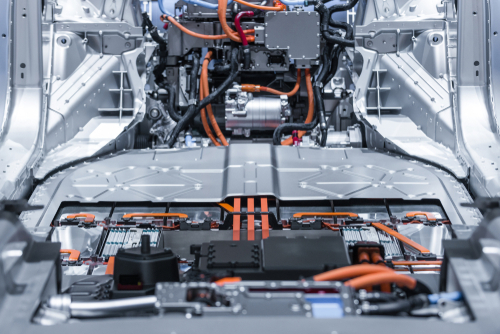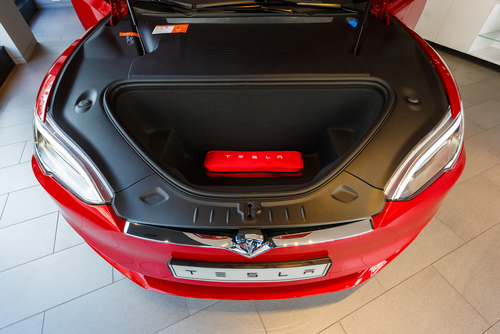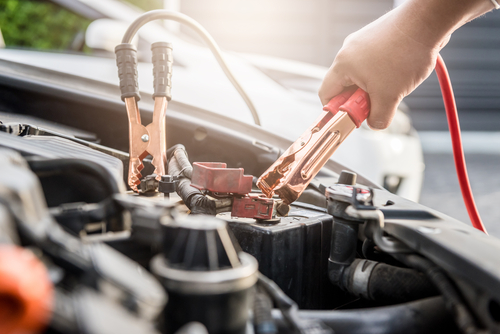Can An Electric Car Give A Jump?
I’ve always wondered if an electric car can give another car a jumpstart. I mean, cars break down all the time and chances are you’ll find one along the road that just needs a boost. Would you be able to resist the urge to help?

The answer is: Yes but you really shouldn’t. All electric cars have a secondary 12V battery which runs the electrical components within the vehicle. This is basically the same energy rating that batteries in conventional cars have.
Electric cars have a main battery grid that powers the entire car and allows for it to turn the wheels. This is where all the electricity you derived from a charging station or from the wall. This is where all of your electricity is stored. It also acts as the fuel needed in place of fossil fuels.
This storage unit stores energy but cannot create energy on its own. You will need a charging unit to provide it with the power it needs. It’s a good thing that charging stations are becoming very popular nowadays and you can always find one within range of where you live.
Or you could just plug it into a socket in your home to power it up overnight. This is what most electric owners do and it’s a very convenient because it’s in your home and you can do it while you sleep.
So Why Not Use Your Main Battery Grid?
Using your main battery grid which is rated at 400V would definitely fry the other car’s battery, so that’s out of the question. That’s just too much energy flowing from your car to the other car. Your 12V battery is basically connected to this grid anyway so it can draw power from that and transfer it to the other car.
Your main battery grid is where you store energy that is converted to electricity that then drives your electric car.
For a better understanding of how it all works, keep reading below.
How Do Electric Vehicles Work Anyway?
Electric vehicles are still complicated pieces of machinery that not everyone can readily understand. So, comparing it to a conventional car, is inevitable. Let’s do a comparison:
How Do Conventional Cars Work?
Conventional cars can be broken down into the most important component: the combustion engine. All conventional vehicles work on the same principle of mechanical energy being derived from burning fossil fuels.
Aside from that, cars also have batteries and alternators to store mechanical energy from the engine. The alternator basically takes the mechanically generated energy your engine creates and stores enough of it to help power your ignition and other electrical components of the car’s system.
So, in essence you have your fossil fuel going into your engine to burn which then turns the pistons. This provides the mechanical energy that turns the belts and pulleys powering the entire system.
How Does An Electric Vehicle Work?
To put it simply, an electric vehicle needs electrical energy to act as fuel. This is stored in the battery grid with a run-off leading to the 12V battery needed to run the smaller electrical components of your car.

The wheels use brushless motors to turn it. It also has regenerative braking so when you stop or slow down, it returns the energy back to the main grid.
Misconceptions About Alternators, Electric Cars And Perpetual Motion Machines
Some people have wondered if installing an alternator in an electrical vehicle will turn it into a perpetual motion machine. Sadly, this cannot work for the simple fact that alternators can only give back the same amount of energy that flows through it. It also needs mechanical energy to power it.

Some people are disappointed that electric cars can’t run forever or as far as most cars do on a single charge. We have to return to the basic principle of fuel as an energy source. In this case electricity is the fuel and since an electric car cannot generate its own electricity, it will eventually run out.
Comparing it to a conventional car, when you don’t have any fuel, your car won’t run too.
Perpetual machines work best with a catalyst and in a vacuum.
What If You’re The One Needing A Jump?
What if your electric vehicle is the one that breaks down and needs a jump? This is a very unlikely thing to happen with all the safeguards put in to electric cars today.
But it does happen from time to time. If you have a dead battery and you’re stuck in the middle of the road, that means your entire battery grid has been drained of stored energy. This is more of a human error than a mechanical one.
Still, a short can happen that would hasten the drain, drastically hastening your consumption. For this, you’d have to contact your manufacturer.

Getting a jump from a conventional car will only provide power to your secondary battery first with the run off leading to your main battery grid. Completely powering up would take hours and that good Samaritan might think it would be better to just have your car towed. You could end up with just enough energy to limp a few miles. You better hope there’s a charging station nearby.
Getting a jump from another electric car can leave you both drained and it will also take roughly the same amount of time.
So if you’re ever broken down on the side of the road and need a jump, you’d best hope it’s a Tesla Cybertruck. That monster can load your car up and bring it to the nearest charging station. Or it could have a generator loaded at the back that you can use to derive energy from. Oh, and you’ll have to wait until 2021 for that to happen.
How To Prevent Energy Loss In Conventional Cars And EVs
So it all boils down now to how to prevent energy loss from happening in the first place. For conventional cars, batteries last 2 to 5 years depending on use and preventive maintenance. We can’t stress enough that you need to have it checked regularly. That holds true for maintenance-free batteries too.
It would also be best to ensure your alternator is working properly. A faulty alternator provides inconsistent power delivery. You can pre-empt this if you notice your lights are getting dim or simply by checking the date of battery purchase.

For electric vehicles, your main grid needs preventive maintenance too. A short can provide a power leak that will severely hamper your EVs operational reliability. Your secondary battery will also need the same type of treatment. Replace it within the prescribed amount of time based on its longevity.
The good thing about the main grid is that: you can replace the components if there are any defects or if excessive wear and tear is noticeable. Its best you contact your manufacturer for a factory approved and installed replacement.
There are indicators within your cockpit warning you of any malfunctions that you can rely on because it is a totally independent system powered by a separate battery. If any indicators light up, it’s best you heed it at once and have your EV checked.
So Why Isn’t It Advisable To Jumpstart Another Car With Your Electric Car?
Your electric car is a complicated piece of machinery run by computers. Everything goes through a computer the fluctuations that could occur when you transfer battery power to a downed car has the potential of negatively affecting your entire system.
Your 12V battery which operates separately to power your internal system is still highly dependent on the energy it derives from your battery grid. There are safety measures put in place but that doesn’t completely safeguard you from a power surge. When that happens, you now have two cars left on the side of the road and dead in the water.

So if you really must help, get your cellphone out and dial Triple A.
Related Questions:
Why Don’t Electric Vehicles Have Alternators?
Electric vehicles don’t have alternators because of the way it derives energy from the mechanical action of an engine. Conventional engines need fossil fuel for combustion. Electric vehicles don’t have these engines nor the need for fossil fuel. It therefore has no need for an alternator to operate.
Why Not Install Alternators In An Electric Vehicle’s Wheels?
An electric vehicle’s wheels already have the ability to perform regenerative braking which basically recharges the battery within your EV when you press the pedal to stop or slow down. This is almost the same as how an alternator functions without the need for combustion or the use of fossil fuels.

How Long Does It Take To Charge An Electric Car?
This is highly dependent on the size of your battery or the level of stored energy it has. A fully depleted, standard size battery grid can reach its maximum capacity at under 12 hours using a 7kW wall socket. It’s faster if you use designated charging stations as these produce more power for EVs.